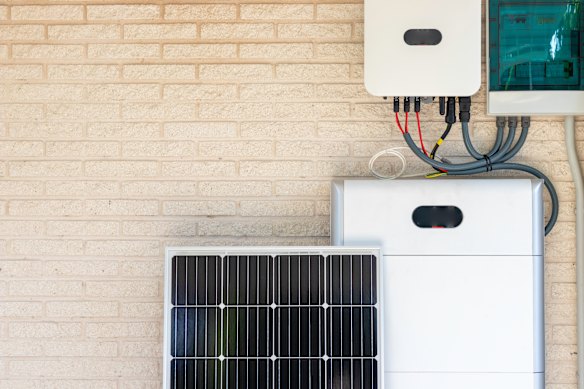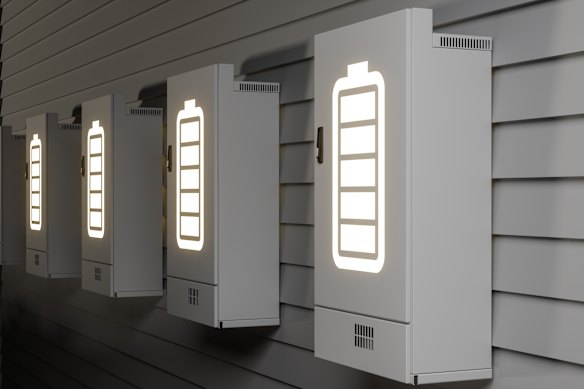Sick of power bills? What you need to know before buying a home battery
By Mike Foley and Nick Toscano
New rebates that wipe 30 per cent off the cost of buying and installing home batteries are proving wildly popular across Australia, igniting a rush of sales that experts and industry leaders are likening to the solar panel boom of the late 2000s.
Pairing solar panels with a battery brings a range of benefits: stashing excess solar to use later can slash electricity bills, provide back-up in the event of blackouts, reduce a household’s reliance on the grid, reduce its carbon footprint, and smooth out volatile wholesale power price swings that ultimately flow through to all consumers.

Home battery sales are booming. Credit: Getty Images
But battery buyers are being warned that, although the technology could vastly reduce household electricity costs, it may take years to recoup the $10,000-plus outlay. And some cheaper, smaller-capacity batteries may be unable to stash enough juice to get households through the evening peak demand periods – when the sun sets and appliance use rises – without needing to draw from the grid.
We spoke to a range of experts to break down the many often confusing choices customers face – including what size system they need and how much they need to spend – to select the right model and make of battery from the dizzying array of options.
What is the rebate and how do batteries work?
The Albanese government’s Cheaper Home Batteries Program was one of its key election pledges, offering a 30 per cent rebate on the purchase and installation costs of a home battery from July 1.
The scheme is limited to homes with solar panels, but householders are still eligible if they install panels and a battery at the same time.
The scheme, which is limited to one system per premises, is not capped by a dollar amount, but by battery size: five- to 50-kilowatt-hour capacity products are eligible for support, and total capacity cannot exceed 100 kilowatt-hours.
A kilowatt refers to the rate at which something can charge or discharge energy, whereas a kilowatt-hour (kWh) measures the amount of energy it can store. For example, a one-kilowatt-hour battery can pump out a kilowatt of energy in 60 minutes.
An average household of four residents, with two adults and two children, should consider installing a 10 kWh to 15 kWh battery, given they had at least an average-sized rooftop solar panel installation, said experts spoken to for this article.
Many would-be buyers may have heard of better-known battery systems, such as the Tesla Powerwall, or China’s BYD, but as you begin researching, you will probably encounter other popular brands, such as LG, Sonnen and Sungrow. This article provides general advice only, and home owners should get quotes from several installation companies to seek advice on their options.
How much will a battery cost?
With the government’s 30 per cent rebate on the purchase and installation costs, a customer can expect to pay about $9000 to $15,000 for a model in the recommended size range.
A typical household in Melbourne and Sydney now pays between $1500 and $2000 a year for electricity.

The federal government’s 30 per cent subsidy on home batteries has fuelled a huge rise in demand.Credit: Getty Images
Households with solar panels will typically pay less than this, given they can use their own supply to run their appliances during the day and earn money by exporting power to the grid.
Experts, as well as the federal government, told this masthead that installing an appropriately sized battery to soak up rooftop solar power could reduce household bills by $1000 a year, on top of savings generated by the solar panels.
Can I save money with a small system?
Finn Peacock, chief executive of leading quote-comparison service SolarQuotes, said it appeared that many battery customers were considering small, relatively cheap systems of 5 kWh – the minimum allowed under the rebate scheme – which could cost as little as $5000 to install.
However, a battery of this size would end up proving “tiny” for most households, he said.
“If you’ve got your air-conditioning on, in a decent sized Aussie home, that might pull three kilowatts easily. If you’ve got three kilowatt-hours of storage left, that’s going to last an hour,” Peacock said.
“Most households’ sweet spot would probably be 15 to 20 kilowatt-hours.”
Customers who focus too heavily on the length of the payback time and opt for a 5 kWh battery instead of a bigger one that could nearly eliminate the need for grid power, may end up “miserable”, Peacock said.
“Very quickly they are going to see that they are still pulling from the grid after that battery is drained at 6 or 7 o’clock, and that just makes battery owners miserable,” he said. “If you size a battery for zero bills, you’re going to need a much bigger battery than if you are optimising a faster payback, but [lower bills] is where the long-term satisfaction comes from.”
How to use a battery
Australian National University emeritus professor and solar energy pioneer Andrew Blakers said greater savings were available for households with batteries that replaced their gas heaters and cookers with electric appliances.
“If you’ve got $10,000 or $15,000, which is what it’s going to cost for a good-sized battery, then getting off gas would be my No.1 recommendation by far,” Blakers said.
That’s because they will avoid both the cost of gas and the fixed network charges for delivery of the fuel.
Blakers agreed that the average household should shop for a battery in the 10 kWh to 15 kWh size range.
“That gives you enough flexibility to stoke up a large fraction of the energy from your solar panel on the roof … and then spread it three ways – into your home battery, into your hot water tank, and into your EV – remembering to preheat your house or pre-cooling your house before you get home, for example,” he said.
Peacock, who sold SolarQuotes to Origin Energy last year, said buyers should be aware they can still waste energy and cop power bills with a battery installed on their dwelling.
“I worry about people thinking batteries are the magic bullet – always bear in mind that batteries store energy, they don’t generate it,” he said.
“The thermal envelope of most Aussie homes is really horrible. People are dropping $10 to $15,000 on a battery, but are often still not sealing the gaps in their homes. Don’t forget about the thermal envelope of your home.”
How to choose a battery
Batteries may take 10 years, or more in some cases, to deliver enough bill relief to repay their price. But they should remain in warranty during this period, with most models offering a guarantee of a decade or more.
There are about 80 household batteries on the Australian market, starting at about $4000 for a 5 kWh unit, data compiled by the Smart Energy Council industry group shows.
The nine systems with a 10 kWh capacity cost up to $10,000, and a handful of models with a capacity exceeding 13 kWh retail from $15,000 upwards.
Mike Roberts, senior research associate at the University of NSW School for Photovoltaic and Renewable Energy Engineering, said the best way for a home owner to choose a battery was to seek independent advice.
Reputable installation companies are a valuable source of information and will assess a customer’s power bill, energy use patterns and solar system and advise on the best purchase.
Another source of advice is the independent SunSPOT website. Developed by UNSW experts and not-for-profit solar research organisation the Australian PV Institute, it provides an energy calculator that assesses a household’s solar power, energy use and battery potential and forecasts bill savings.
“If you’ve got your address, we can look at your roof, we can see if you have, and then we work out how much they’ll generate over the year,” Roberts said.
“You can also work out what would happen if you add more solar or replaced it with a new system, or added a battery.”
Uptake of batteries has surged since July 1, when the rebate scheme opened, with installers and advisory services such as SolarQuotes reporting a 500 per cent rise in sales and inquiries.
Peacock said the battery boom reminded him of the solar panel boom, which began in 2008 when the first states offered generous payments, or feed-in tariffs, to households that supplied solar power to the grid.
For a list of batteries approved for use under the Cheaper Home Batteries Program, visit the Clean Energy Council approved products list. Lobby group Solar Citizens also has a list of state government support programs.
Cut through the noise of federal politics with news, views and expert analysis from Jacqueline Maley. Subscribers can sign up to our weekly Inside Politics newsletter here.